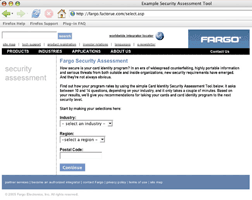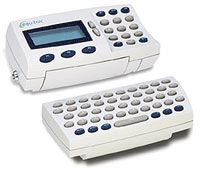 How secure is your ID card system? Fargo Electronics wants to help you find out. They have developed a series of self-assessment questions that will help card managers determine the gaps in their ‘supposedly’ secure ID cards. This non-proprietary interactive website tool was launched in April.
How secure is your ID card system? Fargo Electronics wants to help you find out. They have developed a series of self-assessment questions that will help card managers determine the gaps in their ‘supposedly’ secure ID cards. This non-proprietary interactive website tool was launched in April.
“We felt there was an awareness that needed to be driven home,” said Joe Wright, Fargo’s marketing director. “We wanted to make end users realize their vulnerabilities.”
A couple years ago, Fargo discovered that “a lot of customers didn’t realize the lack of security with their card system, card issuance process and the card itself. We wanted to develop a tool that would help users realize the level of security, or more importantly the risk, associated with their card program,” he added.
The page, available at http://www.fargo.com/assessment/select.asp, covers three vertical markets – corporate, education, and government. “The majority of our business falls in these three areas,” he said. Users also have to identify the area of the world they’re from, such as the U.S., Canada, Latin America, Europe, Middle East, Africa, or Asia Pacific.
 After choosing the area and region, and inserting a zip code, users then are asked to respond to between 10 (education) to 14 (government) questions.
After choosing the area and region, and inserting a zip code, users then are asked to respond to between 10 (education) to 14 (government) questions.
A common question among all three is the current state of the organization’s security system, i.e. what are they now doing to prevent forgery or preventing the card from being used by unauthorized personnel.
“It’s unfair to think that 14 questions online on the Internet will solve their security problems,” said Mr. Wright. “Our goal is to make people aware of security issues by asking questions to provide direction, and then give them an estimate of their level of risk.”
The Fargo self-assessment site won’t initially capture any contact information. “We try to remain neutral,” said Mr. Wright. Users can print off a recommendation report on the state of their card’s security which allows them to take this to their security director.” Fargo can also supply a page of recommended solutions, and it is there that a user can request help from a Fargo solution provider, added Mr. Wright.
A demo of the page was unveiled at the recent ISC West security conference. “We got some pretty positive response,” said Mr. Wright. “Many didn’t even realize their ID card system could be at risk. And, manufacturers of access control systems thought this would be a good tool; both for end users and as an awareness tool for sales and marketing.”
The self-assessment wasn’t ready for the NACCU conference, but Mr. Wright said Fargo will definitely demo it at next year’s show.
Mr. Wright believes that there are “two areas for security improvement in colleges; first, investing in a visual security element on the card, either a high secure custom hologram or secure foil card like Verimark or Holomark. College kids are getting pretty savvy with fake IDs.”
Second, he added, “A lot of people forget about their vulnerabilities within the card issuance process and system itself. Students make cards for other students. Staff uses the system for other purposes. There are solutions available to lessen the likelihood of this occurring, such as a lockable hopper or smart card controlled access (for system users and administrators). There are also software-driven solutions where you can control the hours of operation of the system, set-up notifications for misconduct and apply security images. And if you do find a fraudulent card, you need a good tracking method where you can trace the card back to the printer and the operator.”
Colleges also need to realize that ID cards being issued today have a lot more value. “They can be used for access control, purchasing books, lunches, off-site vendors programs, library use, phone cards, financial data and more. They can also be used to log onto the Internet. As that functionality of the card grows, as does its value, you’ve got to do more to protect the card,” said Mr. Wright.
Fargo first started the self-assessment project last November. “It has been six months in development. We wanted to make sure we had the right tool, and we used a third party company to make sure we didn’t start marketing Fargo instead of providing a good assessment tool,” said Mr. Wright.
In addition to a security report on the company, the assessment tool also compares the company or college against others in that industry. Future input received on the site will determine what that average will be, Mr. Wright added.
Now that the site is live, Mr. Wright said the company is investing in a lot of “outbound marketing” to let people know about it.
Note from the editor: Whether you are a Fargo user or not, it is worth the time it takes to enter your information and get your results. You can gain insight into the types of issues that can impact your overall system security … And you might be surprised by your overall threat level, I was! Visit www.fargo.com/assessment/select.asp.
 Trying to account for every piece of paper running through your copiers and printers could be a lesson in futility … particularly for colleges dealing with multiple constituencies, each with different printing needs and different ways of paying for the services. Equitrac, Inc., a Plantation, Florida-based company, has been handling those document accounting functions for the corporate world, primarily law firms, for more than a quarter century. In the past half dozen or so years, the company has moved into the higher education market and is now on its third version of a software product designed specifically for colleges to help them control their copying and printing costs.
Trying to account for every piece of paper running through your copiers and printers could be a lesson in futility … particularly for colleges dealing with multiple constituencies, each with different printing needs and different ways of paying for the services. Equitrac, Inc., a Plantation, Florida-based company, has been handling those document accounting functions for the corporate world, primarily law firms, for more than a quarter century. In the past half dozen or so years, the company has moved into the higher education market and is now on its third version of a software product designed specifically for colleges to help them control their copying and printing costs.
Equitrac’s vice president of technical marketing, Chris Wyszkowski, explained: “Document accounting is all about monitoring and managing the costs associated with document activity, output and input, scanning, faxing, printing. It’s about cost control and cost containment. As in any vertical, such as the education market, document accounting could provide them (universities) with a revenue source.”
Twenty-five years ago, “Equitrac was helping law firms, assisting them to bill their clients for all kinds of documents. Over the past five to eight years, we took what we learned from the legal market and began applying it to other markets,” said Mr. Wyszkowski.
He said Equitrac, in the delivery of accounting systems for legal firms “developed a wide range of relationships with equipment manufacturers (e.g. Ricoh, Xerox). We became recognized as the world-leader at providing document accounting. So, it was actually our manufacturing partners who engaged us to build solutions for the education market so they could sell their modern copiers and enable schools to manage these copies. That’s what created the opportunity and we’ve continued to build on that.”
A specialized system was needed because colleges needed the ability bill the various constituent groups appropriately.
At a law firm or corporation, you have one set of constituencies, the employees. But, said Mr. Wyszkowski, “At a university, you have a few groups of people using it; students, who might be on a quota or payment system; staff, who use the printers and copiers as a part of their job with the costs being allocated to a specific department, and faculty, who might have a set number of free copies and need it for their course work…”
 Unveiled at the National Association of Campus Card Users show in March, Equitrac Express 3, includes several new features, such as allowing students to preview their documents and to send their jobs to any “device group” printer. For example, Mr. Wyszkowski explained, a student sends a print job to the system. He is told how much it will cost him. He agrees with the cost (there are several payment methods, including stored value on a card specifically set up for the print program, or through his campus or credit card), okays the job, which is then placed in a print queue. The student can then go to any printer in the “device group” to retrieve his job.
Unveiled at the National Association of Campus Card Users show in March, Equitrac Express 3, includes several new features, such as allowing students to preview their documents and to send their jobs to any “device group” printer. For example, Mr. Wyszkowski explained, a student sends a print job to the system. He is told how much it will cost him. He agrees with the cost (there are several payment methods, including stored value on a card specifically set up for the print program, or through his campus or credit card), okays the job, which is then placed in a print queue. The student can then go to any printer in the “device group” to retrieve his job.
“Express 3 is really focused on allowing different constituencies – student, faculty and staff – to have access to the same device but with different billing requirements depending on who they are,” said Mr. Wyszkowski.
“Our product will work for virtually any size campus. We have a small campus edition, used by small campuses or a single department with a single server. We also have a suite version that’s scalable to large organizations, with multi-server deployments, encompassing campus scenarios with thousands of printers and tens of thousands of users,” he added. He estimates Equitrac solutions are currently in “hundreds of colleges.”
The new version also offers a “significant set of improvements from an IT standpoint. It supports all the major operating systems, Windows, Novell, Unix, Linux, Macintosh. And no matter the type of infrastructure, you can integrate it into your print environment,” he added.
 By enabling campus-wide billing integration, Equitrac’s Express also eliminates the need for separate printers and copiers for students, faculty and staff, allowing schools to more efficiently assign device resources across campus.
By enabling campus-wide billing integration, Equitrac’s Express also eliminates the need for separate printers and copiers for students, faculty and staff, allowing schools to more efficiently assign device resources across campus.
Equitrac will also work “with backend campus card solutions. We have an existing interface with Blackboard and we’re investigating adding interfaces for Diebold and CBORD,” he said.
This business has been growing steadily as document production becomes an increasingly larger output at a business or university. “In some organizations, it’s a fariy high expense item. If you can control it and save 25% off your document processing, that can be quite a significant savings,” said Mr. Wyszkowski.

To read about Equitrac’s solutions for higher education on the web, click here.

At the recent National Association of Campus Card Users conference in Orlando, I spoke with several bankers and a number of campus administrators about credit cards. Though far from a scientific study, the conversations suggest to me that the issue of campus cards and credit may be heating up again. In the late 90’s, during the heyday of the affinity credit card expansion, issuers were racing to ink deals with like-minded groups providing cards to group-members that suggested and ‘supported’ the group’s mission. From sports teams to hobbyists, everything was fair game. And college alumni organizations were among the most sought-after categories.
As the signing bonuses and incentive pay provided to major alumni associations grew well into the tens of millions of dollars, the idea of capturing the students before they became alumni (and before the issuer was required to fork over the major dollars) was borne. For years, credit card solicitation tables at events and in student unions were prevalent. But this was a slow churn process and the playing field was level for all issuers. How could one gain massive advantage?
Enter the campus card program … well-established on campus, respected by students and parents, versed in offering/marketing card-based services to campus populations. The fit seemed natural. In addition, card offices were more entrepreneurial than typical campus departments and, almost without exception, they were searching for funds.
Obstacles abound …
When the credit card issuers came calling, however, they quickly found roadblocks that were not encountered in traditional affinity card relationships. A string of emotional, technical, and financial obstacles emerged.
First, a very strong sentiment against ‘institutionally-endorsed’ credit existed among many in the various campus populations. Outspoken students, outraged parents, and gun-shy administrators let it be known that this would not be a hassle-free initiative.
From a technical standpoint, it became clear early on that the issuance of the cards would pose a problem. Most campus card programs required instant issuance so that the student could use the card for essential services (e.g. dorm access, dining, library services) immediately. The major credit brands required that their cards be issued in secure facilities using strictly controlled processes to reduce fraud and counterfeiting. Because students could not wait a week–or even a day—for their ID card, the idea that the actual student ID would double as the credit card took another blow.
Issuers also ran up against financial hurdles. Many administrators stressed that if a credit product was to be issued as a part of the card program, it would have to be available to all students. Credit card issuers, however, use guidelines to restrict the provision of credit to those deemed good candidates for repayment. Students with negative credit ratings did not fit the model, and in many cases, students with no credit rating (arguably the majority of incoming students) would be declined as well.
So what has changed?
The obstacles described above effectively killed the issuance of credit via the campus card in all but a few limited trial programs. Does the current re-emergence of the discussion suggest that times have changed or is it simply talk?
To a certain degree, each of the obstacles still remains though their severities have diminished. Credit is still a ‘dirty word’ to some on campus, though the culture—both on campus and in the country as a whole—seems more tolerant. The staggering statistics regarding student credit card usage show that credit is a fact of life for college students. Perhaps institution-endorsed credit, coupled with mandatory responsible credit education, would be preferable to the current chaotic environment.
The technical issue of instant issuance has been overcome to a large extent as demonstrated by the host of campuses that have successfully deployed Visa and MasterCard branded debit products. Innovative issuers have created mobile secure issuing facilities while others have built processes that issue temporary cards to enable campus functionality while the branded card is processed and mailed. These same solutions could readily apply to credit issuances as well.
Finally, several of the issuers I have spoken with suggest that they understand that 100% acceptance may be required. It has been suggested that a limited-line (e.g. $200) could likely be offered to all individuals with higher lines for those that qualify.
The future campus cards and credit
While it does seem that some of the issues that derailed it in the past may have eased, this is still a thorny issue. What will happen in the coming years? Only time will tell. Certainly a major driver for the inclusion of a credit product from the campus perspective is the potential funding source from up-front and/or ongoing revenue sharing. Card programs continue to seek new sources as pressure to be self-supporting continues to mount. Stay tuned.
Article written by CR80News Editor Chris Corum

